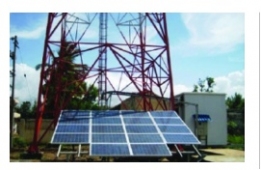Tower Power - Infrastructure providers experiment with renewable energy sources

-
Telecom operations in India are characterised by falling revenue realisations per minute, increasing minutes of usage, falling ARPUs, increasing passive capex spend, deteriorating grid availability, and increasing operational costs. New rollouts will also entail higher opex and lower ARPU margins, resulting in strained EBITDAs. The success of a telecom operator depends on several criteria including the ability to provide minutes at the lowest possible cost, develop new and innovative value-added services, cut operating expenditure and attract a higher number of subscribers.
Available grid power is often unreliable or is prohibitively expensive. Consequently, telecom towers will be heavily dependent on off-grid power. The main off-grid power source for telecom towers is diesel generator (DG) sets, which are expensive and require regular refilling of fuel and maintenance. Moreover, diesel is subject to theft in rural areas. Finally, the price of diesel fluctuates considerably and increasingly constitutes a higher proportion of the operating expenditure.
The main challenge before operators and infrastructure companies is that 35 per cent of the site's operating expenditure is related to energy costs. Moreover, 70 per cent of the site's downtime issues are linked to the passive infrastructure present at the site. In this context, green power is a viable solution. The challenges associated with such an alternative are as follows:
Acme Tele Power offers an entire portfolio of solutions for various site-related challenges. For instance, increasing site operational costs can be mitigated with a DC powerhouse of 5 kW, which lowers back-up and air conditioning costs. Similarly, site downtime can be reduced with NextGen thin-plate technology and a very high MTBF generator. Other alternatives include a next-generation green shelter, a DC-powered cell site comprising an indoor or outdoor base transceiver station; a fuel cell powered cell site solution; hydrogen fuel cells and solar-powered cell sites.
Joseph Hickey, Executive Vice-President and Head, Energy Management Services, Acme Tele Power
The demand for power will grow in tandem with the increasing number of towers in the country. To illustrate, more than 200,000 tower units are to be added by 2012. If the average power load is 2.5 kW, the new requirement (once the new towers have been built) would amount to 500 MW. Therefore, there is an urgent requirement for a reliable and cost-effective power source in the country.
Currently, electricity from the grid is frequently unavailable in rural areas and supply is erratic in urban areas. Moreover, while DG sets provide assured electricity, a few operational challenges remain. For example, ensuring a steady supply of diesel is difficult. Similarly, protecting the fuel from theft and high maintenance of the DG set are other challenges. Financially, the biggest challenge is the fluctuation in oil prices, which impacts financial stability and forecasting.
In this scenario, photovoltaics (PVs) are a viable alternative, owing to several factors:
In this regard, solar PV is emerging as a viable option for the telecom industry. Also, several financial benefits can accrue while utilising a PV solution, as compared to a DG set. For instance, PVs require a onetime investment as compared to recurring and unpredictable fuel costs in DGs and the capital expense of a PV system almost double that of a generator.
The key parts of a PV system include the system design, modules, battery bank, charge controller and logic controller.
Moser Baer Photo Voltaic has undertaken several PV projects. For example, the company has set up the Solfocus 500 W grid connect installation in Spain, a 12kWp grid connect system at the DLF Mall in New Delhi and a 1.5 kW stand-alone PV for residential customers in Noida.
Gagan Vermani, Head, PV Systems Group, Moser Baer Photo Voltaic
- Most Viewed
- Most Rated
- Most Shared
- Related Articles
- Manufacturing Hub: India emerges as a ke...
- TRAI performance indicator report for Se...
- Prashant Singhal, partner, telecom indus...
- 2G spectrum scam: continuing controversy
- An Eventful Year: Telecom highlights of ...
- Telecom Round Table: TRAI’s spectrum p...
- Manufacturing Hub: TRAI recommends indig...
- Linking Up: ITIL to merge with Ascend
- High Speed VAS - Killer applications w...
- Bharti Airtel seals deal with Zain - Zai...






